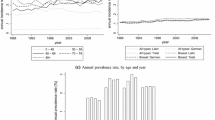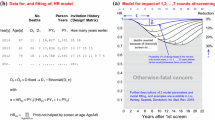Abstract
Objective: This paper presents a methodology for piecing together disparate data sources to obtain a comprehensive model for the use of mammography screening in the US population for the years 1975 – 2000. Methods: Two aspects of mammography usage, the age that a woman receives her first mammography and the interval between subsequent mammograms, are modeled separately. The initial dissemination of mammography is based on cross-sectional self report data from national surveys and the interval length between screening exams is fit using longitudinal mammography registry data. Results: The two aspects of mammography usage are combined to simulate screening histories for individual women that are representative of the US population. Simulated mammography patterns for the years 1994 – 2000 were found to be similar to observed screening patterns from the state level mammography registry for Vermont. Conclusions: The model presented gives insight into screening practices over time and provides an alternative public health measure for screening usage in the US population. The comprehensive description of mammography use from its introduction represents an important first step to understanding the impact of mammography on breast cancer incidence and mortality.
Similar content being viewed by others
References
RA Smith D Saslow KA Sawyer et al. (2003) ArticleTitleAmerican Cancer Society Guidelines for Breast Cancer Screening: update 2003 CA Cancer J Clin 53 141–169 Occurrence Handle12809408
InstitutionalAuthorNameU.S. Preventive Services Task Force. (2002) ArticleTitleScreening for Breast Cancer: Recommendations and rationale Ann Intern Med 137 344–346
SA Newell A Girgis RW Sanson-Fisher NJ Savolainen (1999) ArticleTitleThe accuracy of self-reported health behaviors and risk factors relating to cancer and cardiovascular disease in the general population A critical review. Am J Prev Med 17 211–229 Occurrence Handle10.1016/S0749-3797(99)00069-0 Occurrence Handle10987638
R Ballard-Barbash SH Taplin BC Yankaskas et al. (1997) ArticleTitleBreast Cancer Surveillance Consortium: a national mammography screening and outcomes database AJR Am J Roentgenol 169 1001–1008 Occurrence Handle9308451
EM Rogers (1995) Diffusion of Innovations EditionNumber4 Free Press New York
InstitutionalAuthorNameResearch Triangle Institute (2002) SUDAAN User’s Manual, Release 8.0 Research Research Triangle Institute Triangle Park, NC
V Mahajan RA Peterson (1985) Models for Innovation Diffusion. Sage University Paper Series on Quantitative Applications in the Social Sciences. Sage CA
SH Taplin L Ichikawa DS Buist D Seger E White (2004) ArticleTitleEvaluating organized breast cancer screening implementation: the prevention of late-stage disease? Cancer Epidemiol Biomar Prev 13 225–234
Cronin KA, Izmirlian G (2003) Calculation of hazard rates for external-internal influence diffusion of innovation models. National Cancer Institute, Statistical Research and Applications Branch Technical report. (Accessed on 1/6/2005 on http://srab.cancer.gov/reports/)
M Aitkin D Anderson B Francis J Hinde (1990) Statistical Modelling in GLIM Oxford University Press New York
TM Therneau PM Grambsch (2000) Modeling Survival Data: Extending the Cox Model Springer-Verlag New York
JP Klein ML Moeschberger (1997) Survival Analysis Springer-Verlag New York
SAS macro for the semi-parametric Gamma frailty model, Medical College of Wisconsin (accessed on 1/6/2005 on http://www.biostat.mcw.edu/SoftMenu.html)
Yu B (2005) Estimation of shared gamma frailty models by a modified EM algorithm.Comput Stat Data Anal (In press). Available online 12 October 2004.
N Breen DK Wagener ML Brown WW Davis R Ballard-Barbash (2001) ArticleTitleProgress in cancer screening over a decade: results of cancer screening from 1987, 1992, and 1998 national health interview surveys. J Natl Cancer Inst 93 1704–1713 Occurrence Handle10.1093/jnci/93.22.1704 Occurrence Handle11717331
LS Caplan MT Mandelson LA Anderson (2003) ArticleTitleValidity of self-reported mammography: examining recall and covariates among older women in a health maintenance organization. Am J Epidemiol 157 267–272 Occurrence Handle10.1093/aje/kwf202 Occurrence Handle12543627
Author information
Authors and Affiliations
Corresponding author
Rights and permissions
About this article
Cite this article
Cronin, K.A., Yu, B., Krapcho, M. et al. Modeling the dissemination of mammography in the United States. Cancer Causes Control 16, 701–712 (2005). https://doi.org/10.1007/s10552-005-0693-8
Received:
Accepted:
Issue Date:
DOI: https://doi.org/10.1007/s10552-005-0693-8




